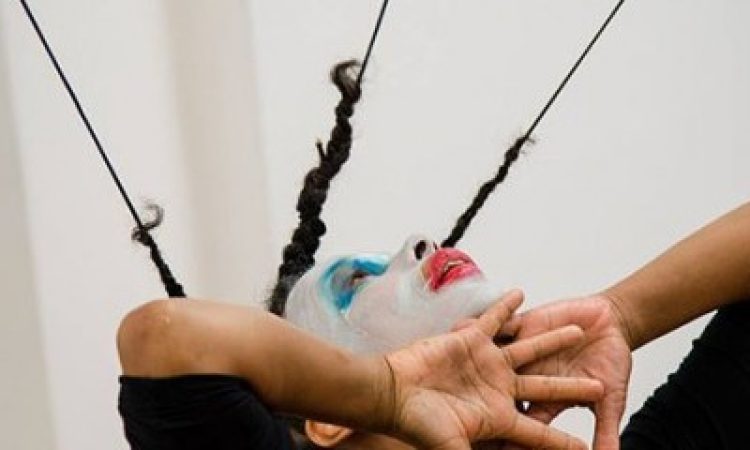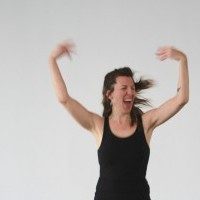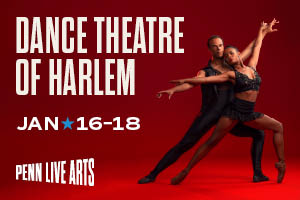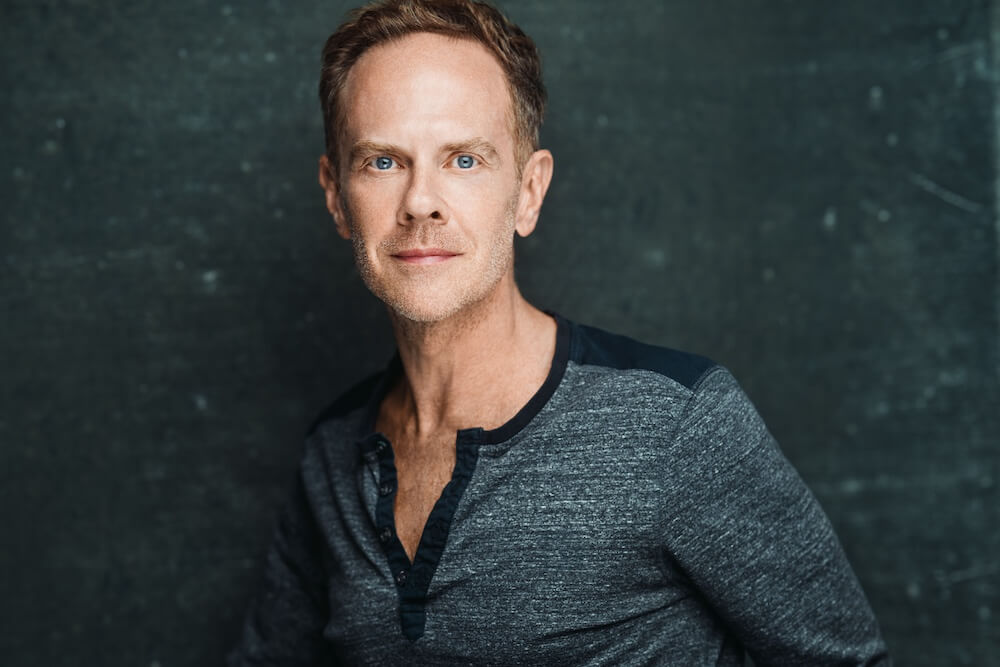All bodies are made of the same organic components, a fact which both defies and defines the expression of our individuality and culture. For me, the process of making, sharing, and seeing art has always been a way to explore ideas and to expand my experience of being human. But what if we could go deeper? What if we could be in the shared space of performance with our senses alive, with the edges of our perceived identity blurred just enough that a deeper alchemical interchange could take place?
We climb the hill, in the darkness, stone by stone. I can barely make out the silhouette of my fellow comrades collecting around a dim light. I breathe deeply as the image unfolds, my eyes adjusting, searching.
Sitting on a chair in the fire pit is Edisa Weeks—an African-American woman, her face painted in rough clown white, giant blue circles around her eyes and a hint of red lips. Her hair, twined tightly to six ropes, is connected to a great web above us reaching in all directions, connected to pulleys with objects dangling on each end: a rubber chicken, a book, a light bulb, a knife, a bundle of sticks, and something else that I can’t see. Her face is lit only by a computer on her lap. She is still, her eyes downcast.
It is a Saturday night in August, after two full days of workshops in the woods of western Massachusetts at Moving Arts Lab—a Festival for Interdisciplinary Exploration with the International Interdisciplinary Artists Consortium. Tonight, we witness the teachers sharing their own work. In the darkness on the hill (and now, many months afterward), it is hard for me to separate the vulnerable, heightened senses—awakened through the artist-led workshops—from the way I am experiencing these performances.
_____________________________________________
For each workshop session, the participants choose one of three workshops. My first is BodyNature, led by Philly-based artist Esther Baker-Tarpaga. My core strength is activated through a push/pull play with the ground, outside in the sun. Then, we sit face-to-face, eyes to eyes, for five full minutes with a lab-partner.
Eyes to eyes
A reflection of myself
Vacillating, shape-shifting
Between seeing, being seen
Opening, residing in the light and shadow
Of time rolling across the altering landscape
The earth rising up
Our histories meeting
Our ancestors meeting
Resonating within layers
Of mystery still
Strumming within the cove of the heart
Already, the edges of my identity are beginning to melt; the boundaries between self and other softened.
She asks us to make physical contact with a new partner, and with our eyes closed, take a walk together through the garden. Traveling into the unknown, we rely on our other senses. We are alone and together, skin and hair reaching out to read what lies before us.
_____________________________________________
“When we let go of the grip of the logical mind, and open to more intuitive space, … we begin to feel each other as part of a larger whole … or organism even. We begin to feel true empathy, we begin to know ourselves in relationship to each other, and the larger field of humanity,” says Maré Hieronimus, an artist and workshop facilitator who is part of the Consortium.
In her workshop “Somatic Practices for Traveling Between the Worlds,” we work with deep breath exercises, and the resonance of the water of the body, down into the marrow of the bone. I also attend “Engaging Anti-Racism: Artists as Allies,” with Krista DeNio and Esther Baker-Tarpaga; “#MANAhatta” practice with Jack Gray; and “LEIMAY LUDUS (The Moved Body),” with Ximena Garnica and Shige Moriya.
In these workshops, we explore different forms and disciplines of performance through an international perspective. So, not only are we opening our ways of perceiving, thinking and articulating through different lenses of performance forms, we are also asked to open beyond what is dictated by our cultural point of view. Going into the space of workshop “is not to achieve anything, but to experience what is being offered,” says Peter Sciscioli, the Consortium’s director. We are cultivating a new language, which is built around the experiential process of an idea in one moment of time. It is most powerful when those present are able to blend the edges of their own identities and share the recognition of our ultimate interconnectivity.
This same awareness can be brought to the performative moment itself. As Hieronimus says, performers pass through states of somatic and psychic awareness by calling on a depth of experience, memory, lineage, history, and mythology through their own bodies in that moment. Because of the heightened awareness in this shared space, “the observer has the opportunity to feel the opening of some … trajectory inside [themselves], and to be with it in a new way.”
_____________________________________________
On Saturday morning, I attend class with Jack Gray, a choreographer of Maori Contemporary Dance from New Zealand and his co-facilitator Dako’ta Alcantara-Camacho, an artist from Ilokas Philippines and Guåhan Marianas Islands.
Jack leads our enormous group through a continual flow of earth-rattling steps and cross-body reaches for an hour. I am sweating, battling negative self-talk about the weaknesses of my body, while finding moments of pure delight in rhythm and collective motion. At the end of the series, I find the floor, and sense the life force coursing through me—my logical mind having taken a back seat to this experience. We slowly transition outdoors, where Dako’ta guides us through practices of honoring the ancestors of the land, as well as our own ancestors. As a part of these practices, I find myself in the grass facing the hill, crying. I don’t hide my tears though, or feel embarrassed. The tears are not just tears in this moment. Like sweat, they are material the body produces in the process of change.
“Within our culture, people tend to objectify everything,” Hieronimus says, “which does not allow for deeper exchange. But when [we] can let go of the filter of objectification and enter into a performance experience with the senses alive and [our] own body awake inside of the process and see [our]selves as an active participant, then this is when the greatest alchemical interchange can happen.”
_____________________________________________
I bring all I am and have learned with me to the hill in the darkness to witness one part of Edisa Weeks’s work in progress entitled: THREE RITES: Life, Liberty, Happiness.
Tethered in the fire pit, Weeks begins to move as audio of a man’s steady, monotone voice goes on at length. His subject: the in-depth recounting of the science community’s contribution to the pathologizing of African-American people. Data. Diagnose. Her hands start at her pelvis, moving swiftly in gestures of palm in/out/grasp/fist linking one on top of the other through the solar plexus up through the area of the heart, the throat, open ending at her mouth as she extends her neck back. Higher rates of hospitalization. Her body shaking, shaking, shaking. Higher dosage of drugs. As she stands, the objects that are tied to the ropes drop around us; as she goes down, the objects rise. She sits and wipes the make-up off her face calmly.
In my heightened state of awareness, cultivated over these two days of workshops, I note that I am sensing more. I feel the twines of rope, the weight of objects pulling on my skull; my own body shakes with hers. Weeks has placed herself in a fire pit—conjuring a time when heretics were burned. As a heretic goes against widely accepted truths, so this artist embodies and articulates the wrongs that have been committed against black bodies in a system that should take care of all. I sense risk here, her willing vulnerability, which enables me to meet her with my own. I see my destiny intertwined with hers: our histories and ancestors meeting in this moment, to conduct a process of transformation.
She paints her face again, this time all black, with round white eyes. Again, she moves hand gestures up through the centerline of her body, shaking the objects in the web above her. Again, she sits and cleans her face, this time leaving it unpainted. She begins to undo her hair by hand, slowly unraveling it from the ropes as she sings what feels like a hymn: “We all have to come home again.” An object that has been tied to her hair drops, and another, and another, and we slowly join in singing with her, “We all have to come home again.” The voices lift, echoing through the surrounding woods as she frees herself from these weights. She is among us now and invites us to make a fire as we continue to sing, transforming the place of witness into a space for gathering.
I understand her changing faces, her unwinding the objectifications that keep us from knowing ourselves, of being at home in our bodies, that rob us of the ability to connect, to move freely. I feel this resonating throughout the organic components of my own body—that which is universal. We all will someday return “home,” folded back into the earth.
These two days have awakened in me what is possible, as artist, as audience … and as human moving through this complicated world. I do feel transformed. The raw materials of my body and mind, put through a process of heating up and breaking down, have been mixed and heated with others’ to create a new chemical compound of myself. This is the true act of art-making and of art-seeing.
An exert of THREE RITES: Life, Liberty, Happiness, Edisa Weeks, will be performed at International Human Rights Art Festival, Dixon Place 161a, Chrystie Street New York, NY 10002, Sunday March 5, 2017 at 8:30 p.m., www.dixonplace.org. The full work is set for debut in 2019. For more information: http://www.deliriousdances.com/
Moving Arts Lab, A Festival for Interdisciplinary Exploration, International Interdisciplinary Artists Consortium, August 18-21, 2016, http://www.interdisciplinaryartistsconsortium.com/






